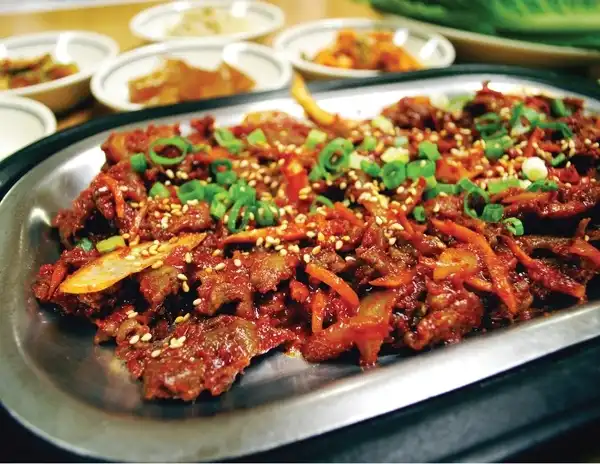Korean For Beginners
Food Reviews
Korea House
1465 S. State Street.
801-487-3900
Monday-Thursday 11 a.m.-2:30 p.m., 5 p.m.-9 p.m. Friday 11-2, 5-9:30
Saturday Noon-3 p.m., 5 p.m.-9:30 p.m.
Jangsoojang Restaurant
2107 S. State Street
801-467-7778
Monday-Saturday 11 a.m.-10 p.m. Sunday Noon-9 P.M.
Closed second and fourth Mondays.
In the nineties, I “enjoyed” Korean food on a number of occasions with a Korean graduate student whom I was tutoring in English. She said she would order food “only Koreans would know enough to savor” and special holiday meals just for Koreans: Think marinated intestine or rehydrated silver fish with raisin-like eyes gazing comatose at you.
I don’t recall ever coming away from these meals without feeling faintly ill or openly disturbed. I have grown up a bit since then, but I clearly still needed help when it came to reviewing the food. [Note: The spelling of these dishes change from source to source. The spellings your find here agree with the restaurant, so confusion will not follow you when you try these for yourself.]
I asked several of my foodie friends to take me to Korean restaurants, and, independently, each ordered exactly the same thing for our meal: Beef Bul Go Gi and Dol Sot Bop along with the customary bowl of rice and various kimchee and vegetable side dishes. The meals were delicious and easy. Bul Go Gi is a Korean style beef barbecue; it is salty-sweet and not too spicy.
It is served with lettuce leaves and a bowl of rice on the side. It is sold everywhere in Korea, even at the 7-Eleven. It is, one might say, Korean for hamburger. Dol Sot Be Bim Bop is rice, vegetables, beef and an egg cooked in a volcanically hot stone bowl, which is then covered with a red spicy sauce. It is a common home dish and often served on airplanes.
Korean food always includes a number of side dishes, usually kimchee, which is a fermented vegetable dish with red peppers, fish sauce, ginger and garlic. Most often, there is a kimchee cabbage with daikon, cucumbers and sometimes sweet potatoes, with some other differently spiced vegetables. Six or more dishes are usually in the center of the table, along with a bowl of rice.
My first pupil ate her kimchee with metal chopsticks in her right hand and a bowl of rice in her left. Taking one nab of vegetable, she set it on the rice and then scooped the rice around it into her mouth. She told me the basis of most Korean meals is simply pickled vegetables and rice.
Korea House is in a midtown spot near Piper Down, with a great reputation for tasty food. The space feels like San Francisco—well lit and accented with blonde wood chairs and wood details. The food is made in a conventional restaurant kitchen and comes to the table succulent, steaming and ready for wolfing down. It is traditional Korean food, but it is easy here—the selections are made for an American-Korean audience, the wait staff speaks fluent English and is very friendly.
The Bul-go-gi ($13.99) is pan-cooked and juicy, with onions and a particularly sweet flavor. The Dol-Sot Bi-bim Bop ($11.90) is mild, nicely arranged and heavy on green vegetables. The stone pot wasn’t extremely hot, but the rice was still lightly crisped. This is a good choice if you haven’t tried Korean food before—there are selections arranged for the beginner or the solitary diner.
Jangsoojang Restaurant is in a run-down building on State Street. Inside it looks like an unlit disco with tables. The place is strange and full of mirrors and haphazard “decorations,” but, sister, the food is generous, really good and it grew increasingly tasty as I ate it. The kimchee sides were replaced as we ate. I am told that the place rages at night on the weekends—Koreans are late night eaters, and know how to have a good time.
This place is more Korean oriented than the Korea House—my server didn’t really speak fluent English. This did not get in the way of my ordering, though. The Dolsot Bibimbop ($10.99) was very generous, and the red sauce was particularly spicy. The Bulgogi ($15.99) was cooked on a portable butane grill, which sizzled on our table. It was easy on the nose, and with its heaping of beef, onions and mushrooms, it was also a topic of conversation.
Korean food changes the way I eat, or changes the way I am when I eat it. My meal becomes a dance, holding a bowl in one hand and sticks in the other, talking with my friend, moving morsels of unexpected flavor to the blank page that is white rice, then to my mouth and then a different bite. There are never less than seven flavors on the table at a Korean restaurant. It is indulgent and luxurious, and when you eat it, you perform a human ritual thousands of years old, which feels as natural as walking or kissing and is just as satisfying.
